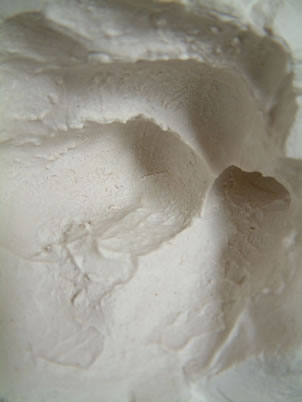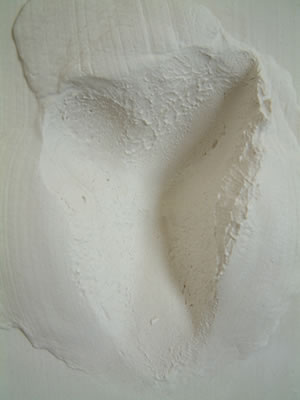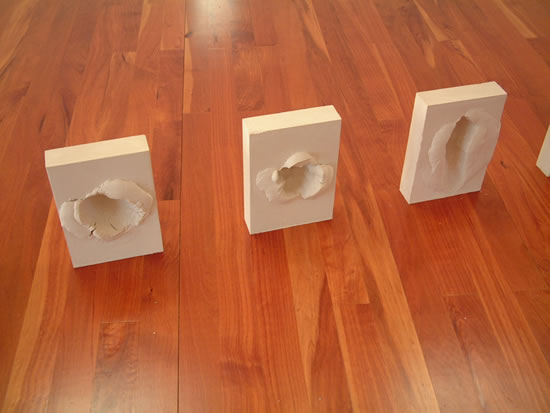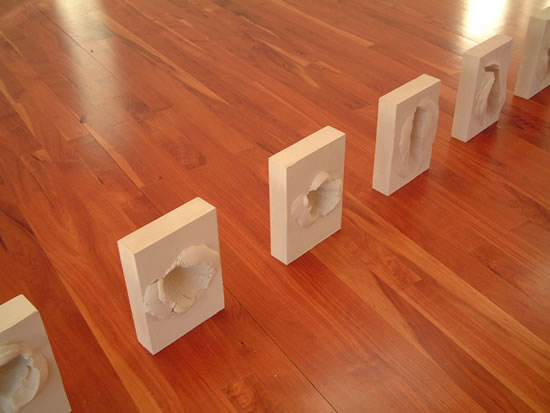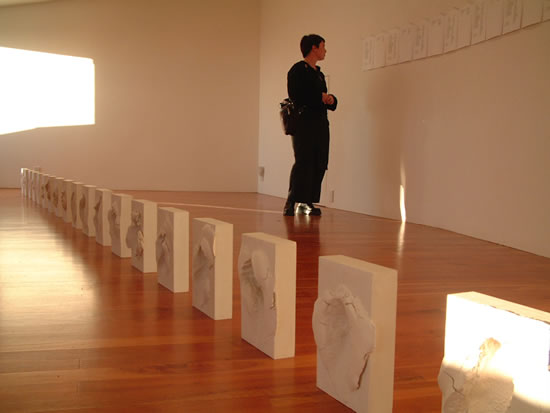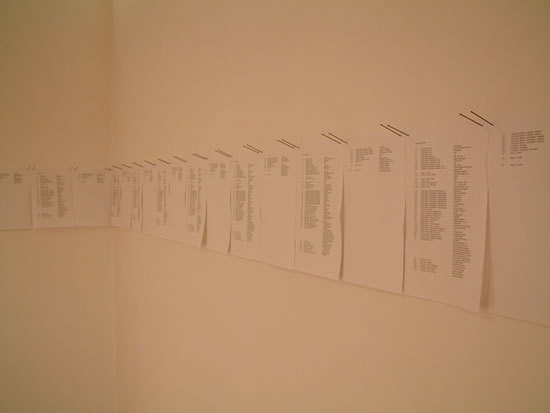Push (2003)
Following the notion of the artist as ethnographer, performing the role of collector of his own gestures, Braddock has catalogued the collection using the Categories for the Description of Works of Art‚ from the J Paul Getty Trust and College Art Association. As stated on the Getty site: “The level of specificity at which an art object, architecture, or group is described will depend on the practice of the individual institution.” Braddock has developed the standard categories of documentation such as provenance, materials, techniques and contexts resulting in an extraordinarily detailed and obsessive description in line with the project’s overall concerns of self-reflection with a focus on the methodologies of how things are collected as well as what.
Description of Artifact:
1.3 Object/Work – Type plaster block
2.1 Classification –Term Creative and Performing Arts
2.1 Classification –Term Ethnography
4.1 Title or Name –Text Push
4.1 Title or Name –Series no. 1
7.1 Measurements – Dimensions 298 X 221 X 82
7.1.2 Measurements – Dimensions – Type height, width, depth
7.1.3 Measurements – Dimensions – Value 298 X 221 X 82
7.1.4 Measurements – Dimensions – Unit mm
8.3.1 Materials and Techniques – Processes or Tec open casting
8.4.2 Materials and Techniques – Materials – Name Calcium Sulphate Hemihydrate (plaster 100%)
14.1 Creation – Creator Christopher Braddock
14.1.3 Creation – Creator – Identity known Aucklander, New Zealand
14.1.4 Creation – Creator – Role Artist
14.2 Creation – Date 2003
14.2.1 Creation – Date – Earliest Date 10.14, 17 April, 2003
14.2.2 Creation – Date – Latest Date 10.46, 17 April, 2003
14.4.3 Creation – Place 47 Rose Road, Grey Lynn, Auckland, New Zealand
18.1.1 Subject Matter – Description – Indexing Terms plaster block
18.2.1 Subject Matter – Identification – Indexing Terms right hand impression
18.2.1 Subject Matter – Identification – Indexing Terms maker’s hand
18.3.1 Subject Matter – Interpretation – Indexing Terms achievement
18.3.1 Subject Matter – Interpretation – Indexing Terms expressionism
18.3.1 Subject Matter – Interpretation – Indexing Terms conceptual
18.3.1 Subject Matter – Interpretation – Indexing Terms auto-ethnography
18.3.1 Subject Matter – Interpretation – Indexing Terms absence
18.3.1 Subject Matter – Interpretation – Indexing Terms phenomenology
19.3 Context – Visual Arts probably sculpture [?]
19.3.1 Context – Visual Arts – Exhibition Event pp37-45
19.3.3 Context – Visual Arts – Exhibition Date 30 August, 2003
19.3.4 Context – Visual Arts – Exhibition Time 1200-1800
21.1 Related Works – Relationship Type probably installation
21.3 Related Works – Identification international visual arts
21.3.1 Related Works – Creator another artist
21.3.2 Related Works – Creator – Qualifier probably art school qualification
21.3.3 Related Works – Creator – Identity any international artist
21.3.6.1 Related Works – Creation Date – Earliest Date c.1969
21.3.6.2 Related Works – Creation Date – Latest Date 30 August, 2003
21.3.10 Related Works – Object/Work Type other plaster sculptures
26.1 Current Location – Repository Name 101 Old Mill Road
26.2 Current Location – Geographic Location Auckland (New Zealand)
26.3 Current Location – Repository Numbers pp37-45803
27.1 Descriptive Note – Text cast white plaster block of rectangular form. The upper surface of the block impressed centrally with an irregular concave pattern by the maker’s right hand being adumbrated into the material when in a semi-liquid state. The upper perimeters of the block slightly raised.
28.1 Provenance – Place Auckland, New Zealand
28.1.1 Provenance – Identity Winstone Wallboards Ltd.
28.1.2 Provenance – Date – Earliest Date 1998, week 27, Wednesday
28.1.3 Provenance – Date – Latest Date exp date, 1 July 1999
28.1.4 Provenance – Date – identity batch no. 827304
28.1.5 Provenance – Owner – Current Christopher Braddock
29.1 Production History – material – measure plaster 5039g
29.1 Production History – material – measure water 4.300l
29.1.1 Production History – atmosphere – measure humidity, 55 degrees
29.1.1 Production History – atmosphere – measure temperature, 16 degrees C
29.1.1 Production History – atmosphere – measure water temperature, 31 degrees
30.1 Condition – Damage none
30.1.1 Condition – Treatment none
30.1.2 Condition – Treatment – prevention keep in safe storage
39.1 Report – Credit Sarah Hillary, Conservator,
Auckland Art Gallery, Auckland
39.1 Report – Credit Christopher Thompson,
Auckland University of Technology, Auckland
39.1 Report – Credit The J. Paul Getty Trust & College Art Associates, Inc.
Push
Caspar Millar
The artist smudged into wet plaster slabs. The impression of his wrists and hands, over and over. There’s a suggestion here of the artist as ethnographer, collecting gestures – a set of body citations. If ethnography is understood as a published description based on fieldwork, these impressions offer the author as the field of enquiry: a kind of typology of one’s own everyday anatomy, and an amateur one at that: a deskilling of the effective plaster cast.
Braddock loves collecting things, is fascinated by bodies and loves pushing his own into warm plaster – he never mixes it with cold water. He once rolled around in wet plaster at art school. He’s always had a thing for serial multiples to the point that he can’t seem to make just one of anything: it has to be an obsessive enterprise, over and over again. These preoccupations share the characteristics of the archive: inherent structural order; seemingly infinite multiplicity; serialisation and a desire for comprehensive categorisation.
What’s of note here is that you might expect continuity. A collection of images that exclude interpretation in favour of narrowed and existing conditions presented by the collection type. But discontinuity follows and a plethora of possibilities. It’s always shocking, how collections of types of things do more than prop up similarities, but provoke differences.
Braddock’s work follows a recent pattern in ethnographic practice that proposes the study of collection methods and patterns of display as a valuable area of research in its own right: how things are collected as well as what. In this sense, twin notions of social constructivism and reflexivity come together: knowledge as the result of social processes and reflexive methods taking issue with the collector’s own bias. It’s argued that ethnobiograhies tell us stories about what people say about each other in local settings: the native gossip. Auto-ethnobiography comes close to gossip about oneself, not normally for publishing: one’s own informant. To collect one’s own gestures is to collate a subjective archive of bodily and emotional projections. Set in place here are the artifacts collected that are themselves the product and imprint of the archivist.
Photographed and out of scale, the gestures read outside the body. Benjamin’s well-quoted exhibition value surpasses any original gesture, and the multiplicity reinforced by photographic mediums floods the already present series of impressions. The fetishised techno-intervention overriding the hand: reproaching the gesture of the push, the smudge of the material no longer the action.
The body’s impression in plaster is originally tied to death: the last imprint, but reproduced in positive again as dead-head. Braddock’s impressions remain concave and hard to read, a shadow of the body-part now absent. They might then be reminiscent of apparatuses of display: the recesses in which the body might lie. Your guess what bit of the body. It’s often argued that photography assists in the death of its subjects. So are there a couple of layers here? In this shift from medium to medium the real becomes an allegory of death and a fetishism of the lost object, in this case, lost gesture. While these shifts are associated with loss of aura, photography’s monumentalising and reproducing capacity displaces that cult-value. Furthermore, two means of reproducibility merge – cast and photograph – as agents of loss.
For references in this text see: Buchloh’s Atlas/Archive in Coles, A. (1999). (Ed).
The Optics of Walter Benjamin. Black Dog Publishing; Söderqvist’s Biography or Ethnobiography or Both? in Steier, F. (1991). (Ed).
Research and Reflexivity. Sage Publications; Baudrillard, J. (1976). L’Echange Symbolic et la Mort.

